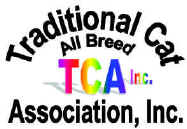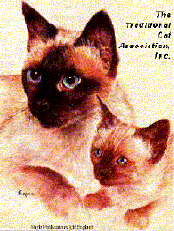
 The
Traditional Cat Association,
Inc.©1987®TM
Official Website
The
Traditional Cat Association,
Inc.©1987®TM
Official Website
Founded 1987, by Diana L.
Fineran
|
" Home of the Traditional Cat"© |
|
Our Motto: To Preserve,
Protect, Perpetuate, and Promote Traditional Cats.© |
|
|
||||
|
|
HISTORY OF THE CLASSIC CORNISH REX ©Copyright, Diana Fineran, May 2006. The origin of the Classic Cornish Rex is considered to be a spontaneous genetic mutation, beginning with a cream colored male kitten born on July 21, 1950 to a tortie and white barn cat, named “Serena” on a farm in Bodmin Moor, Cornwall, England. Nina Ennismore, their owner, discovered this unusual kitten among the litter of five kittens. She named him Kallibunker. Instead of his siblings, who were domestic short hairs with cobby bodies and round heads, Kallibunker was long in body and legs, with large ears a slender tail and a wide, heavy wedge shaped head. Of extra interest was his very special short, coat covered with tight rows of waves or tiny curls, like a wash board. Mrs Ennismore decided to keep Kallibunker as a pet, so she took him to her Veterinarian to be neutered. It was her Vet who recognized this kitten was truly distinguished, and recommended Mrs. Ennismore to consult a British geneticist, A.C. Jude. To perpetuate the special appearance, A.C. Jude recommended that Kallibunker be bred back to his mother, which was done. A litter of three kittens were produced with two having curly hair. A second breeding produced more curly coated kittens. Kalliabunker was bred to Siamese, Burmese and British Domestic Short Hairs, proving the mutation was recessive. Breedings between Kalliabunker’s kittens confirmed that two curly coated cats would produce only curly offspring. With experience breeding and showing Rex rabbits and with familiarity of a similar mutation in mice, Mrs Ennismore named the new breed Cornish Rex, due to its similarity to the curly coated Astrex rabbit. The first presentation of the Classic Cornish Rex to the world came through a short article with photos of Kallibunker and one of his kittens, which was published in Life Magazine in 1956. The following year two Classic Cornish Rex were imported to American from Mrs. Ennismore by Frances Blancheri of California. They were a red tabby son of Kalliabunker named Pendennis Castel, who died shortly after arrival, reports say. The second was a Blue, Kalliabunker granddaughter named, Lamorna Cove, who had been bred to her sire, Poldhu, before leaving England. Lamorna Cove’s first U.S. litter of four kittens contained two kittens who became foundation cats in virtually every Classic Cornish Rex bloodline in the U.S. Marmaduke, a blue and white male, was sold to Helen and Walter Weiss in who’s hands he became the founding father of the Daz-Zling line. Diamond Lil of Fan-T-Cee, a blue and white female, went to Peggy Galvin, who bred her to a Blue Point Extreme Wedge Siamese. This introduced the pointed gene in the color pool. The advancement of the breed in England has two stories, each very different from the other. Still they present portions of the truth. I present them here. The first rendition went this way. In England Nina Ennismore was finding Rex breeding as a financial deficit, as she was having fiscal problems. Sadly she destroyed a number of her Rex cats in 1956, including Kallibunker and his mother Serena. Ms. Ennismore’s reasoning was that Kallibunker was fighting with another male! Only two breeding male Classic Cornish Rex cats remained in all of England! They were Poldhu, a blue cream and Sham Pain Charlie. It was reported, because of Poldhu’s unusual color for a male, a Veterinarian was conducting research in the form of a tissue sample. In so doing the Vet mastered the epitome of bungling twice, first by “accidentally castrating” poor Poldhu, secondly by loosing the tissue sample! Only Sham Pain Charlie remained as the sole breeding male in England to carry on the breed. The second rendition was: A fancier of cats and rabbits named Brian Sterling-Webb, was an experimental breeder. He owned a curly haired male named Kallibunker, who had been born in a litter of barn cats in Cornwall. Kallibunker sired only two litters before he died. Sterling-Webb used two of Kallibunker’s sons and his mother in an effort to establish a curly haired breed. Sterling-Webb called that breed the Cornish Rex, borrowing the “Rex” part from the name given to purebred rabbits with the same kind of coat. Since the breed was moving forward in the U.S., Helen Weiss of Daz-Zling Cattery asked Mrs. Ennismore for more breeding stock, only to be shocked to find out there were none left! This set back created out crossing in the U.S. to several breeds such as Burmese, Havana Brown, American Shorthairs and Siamese to build the breed. Type was compromised for a while. The main result was a wide diversity of colors. Out crossing has been disallowed because there is enough diversity to keep the breed healthy. There is an indirect connection to another Rex breed that came 10 years later. A curly coated, stray, male cat was found in a near by field by Beryl Cox of Devonshire, England in 1960. She named him Kirlee. He was thought to be another Rex outcross to rejuvenate the breed, but when he was bred to curly coated descendants of Kallibunker, all the kittens had straight hair. Kirlee became known as a different Rex, named Gene II. Kallibunker was labeled Gene I. Many of the normal coated kittens were used in Gene I breeding programs. Gene I and Gene II breedings were discontinued, while Kirlee went on to become the foundation of the Traditional Devon Rex breed. The U.S. story expanded when at a California animal shelter an odd eyed, curly coated calico female was found by Bob and Dell Smith of Rodell Cattery. They named her Mystery Lady of Rodell. Subsequently she was bred to a Rex hybrid son of Diamond Lil of Fan-T-Cee, named Fan-T-Cee Blue Boy. The resulting kittens were straight coated. Ultimately, through successive breedings, these cats proved they were Gene I. She is the Rodell Foundation bloodline behind many of the Classic Cornish Rex in the U.S. today. For a while both Gene I (Classic Cornish Rex) and Gene II (Traditional Devon Rex) were grouped together. In 1984 they were divided into separate breeds. The wavy coat is a recessive gene inherited from both parents. Therefore a straight coated kitten from Classic Cornish Rex parents still possesses the recessive Rex gene. When bred to another cat possessing the gene, they can produce wavy coated kittens. Leading cats of note for the breed were Marmaduke of Daz-Aling, GC Fan-T-Cee Fangio of Rodell a blue male, GC DazZling Great White Father, a white male with gold eyes, GC KatzenReich’s Bianka, a white female with copper eyes, GC Keltys Kum Kashu of Ridgways, a male, GC Heatwave’s Vendetta and Milagro’s Lady O’ The Night. As the breed grew an anomaly occurred. One of the breeds distinct features is its wavy coat with out guard hairs, giving the coat an incredibly silky and soft feel. The British accentuated the feel of the coat over the wave, actually breeding for cats with little wave. In the U.S. the accent was placed on the wave of the coat, preserving the breeds wonderful feature. Those people who are cat-allergic may consider owning a Classic Cornish Rex. Because their coats are so short, Rexes don’t deposit as much allergen laced fur around the house. Their short fur also doesn’t hold as much protein secreted by all cats via their saliva and sebaceous glands called Fel d1 on their fur as they lick themselves. They are easy to bath too. Still the Classic Cornish Rex is not considered hypoallergenic. They groom and shed just like any other cat. Some allergic people experience less severe reactions, while others find they are bothered more. It is suggested that prospective, cat-allergic, new owners should spend some time with a Classic Cornish Rex before making the purchase. PERSONALITY OF THE CLASSIC CORNISH REX © Copyright, Diana Fineran, May 2006. The Classic Cornish Rex has a high level of energy and activity with a fun loving attitude. Flayful and inquisitive, everything is a game to them. They need plenty of play room for running and sprinting, and cat trees for their desire to go vertical. New owners must be prepared for their intense activity, which is so endearing. Their typical sociable mood makes them hard to ignore. Their extreme intelligence causes them to follow their people where ever and include themselves in all that is going on. They quickly learn that fun is where their people are. Their extremely affectionate ways cause them to like to snuggle and be loved as much as possible. Some enjoy fetching over and over again. Toys are found any where through out your home. Even personal objects become the toy of choice for a while and owners will find their possessions in far away locals in their homes. They usually don’t tire of a particular toy. They just become enamored with a new one quickly. Child proofing ones home from top to bottom is recommended. The saying goes, the Classic Cornish Rex may grow old, but they never grow up. They never lose their fun loving zest for life A legendary appetite maintains their high activity level, so they require a good amount of food to sustain them. They can be permitted to feed free choice with out having a weight problem. Others will finish every last kernel in the whole bowl. Almost all of them enjoy vegetable favorites such as peas, corn, bean, or broccoli and fruits, usually apples and bananas. The Classic Cornish Rex is a low maintenance cat with nearly no shedding. When no people are around they won’t pine away, yet they are not bashful about demanding attention when people are near. They adjust to traveling with the family or easily stay at home. Touch of Class Cattery reports, “They have the most wonderful calm personalities, very loving and healthy. They love to play. My male is outstanding. He is the best boy. Plus we have the most beautiful kittens from him. He will help care for them and not harm then at all. It is so relaxing to lay down and have 4 Classic Cornish Rex sleeping beside you.” HEALTH OF THE CLASSIC CORNISH REX © Copyright, Diana Fineran, May 2006 Starting with a sound and wide genetic base, the breed is very sturdy and healthy. There are no breed related heath problems. The queens usually require no assistance with kittening. Some will wait for their people to attend to the birthing. Though small at birth, the kittens quickly grow. As soon as they are dry the waves become evident. An added plus is their long life spans, usually to 15 years and even past 20 years. One named Blu Sprs Susannah lived to be 23 years old.
|
|
The Traditional Cat Association, Inc.©1987®TM ALL RIGHTS RESERVED © by John & Diana Fineran - Aug 1999- 2025 No portion of this website or any information contained within it may be copied, or in any way distributed, without the expressed written permission of John or Diana Fineran - No exceptions. |